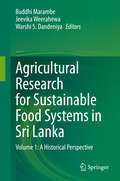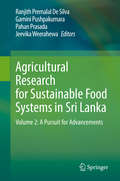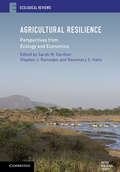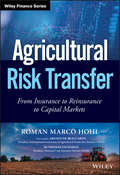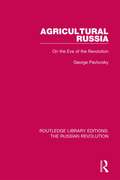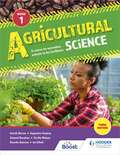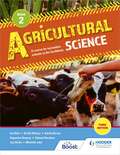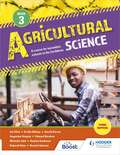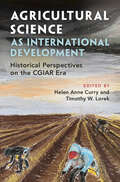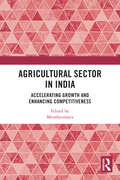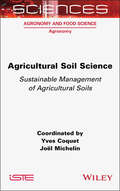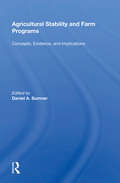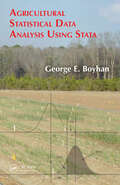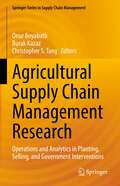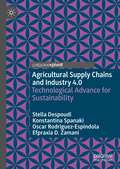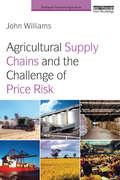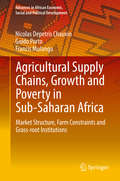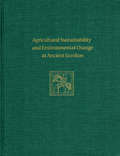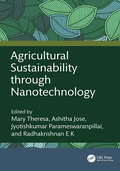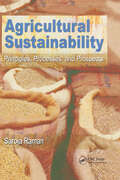- Table View
- List View
Agricultural Research for Sustainable Food Systems in Sri Lanka: Volume 1: A Historical Perspective
by Buddhi Marambe Jeevika Weerahewa Warshi S. DandeniyaA food system comprises the entire range of actors and interlinked activities related to food production, processing, distribution, marketing and trade, preparation, consumption, and disposal. When a food system operates without compromising the needs of future generations, it is considered to be a “Sustainable Food System.” The present-day food systems in Sri Lanka are diverse, and the natural and physical environment, infrastructure, institutions, society and culture, and policies and regulations within which the food systems operate, as well as the technologies employed, have shaped their outcomes. Agricultural research is a key factor in terms of innovation and technological advances. Innovation has been the main driver of food systems’ transformation over the past few decades and will be critical to addressing the needs of a rapidly growing population in a context of climate change and scarcity of natural resources. In addition, agricultural research must help meet the rising demand for food at affordable prices. Comprising 17 chapters written by specialist(s) in their respective subject-areas, this Contributed Volume on “Agricultural Research for Sustainable Food Systems in Sri Lanka: A Historical Perspective” shares the scientific knowledge accumulated by the National Agricultural Research System of Sri Lanka, including universities, and offers recommendations on how to make food systems more sustainable in order to address the current needs of Sri Lankan society. It presents perspectives on four key thematic areas, namely: (i) Crop and animal production, management, and improvement, (ii) Agro-product processing technologies, (iii) Natural resource management, and (iv) Socio-economic development and agri-business management.
Agricultural Research for Sustainable Food Systems in Sri Lanka: Volume 2: A Pursuit for Advancements
by Jeevika Weerahewa Ranjith Premalal De Silva Gamini Pushpakumara Pahan PrasadaFood systems involve a range of activities concerning food production, processing, distribution, marketing and trade, preparation, consumption and disposal. They encompass the path of food from the farm to the dinner table, meeting the food and nutritional needs of a nation. When such systems do so without sacrificing the needs of future generations, they are referred to as “Sustainable Food Systems.” The natural and physical environment, infrastructure, institutions, society and culture, and policies and regulations within which they operate, as well as the technologies they adopt, shape these systems’ outcomes. Making food systems more sustainable is a key priority for all nations, and Sri Lanka is no exception. Food systems deliver optimal performance when the policy and regulatory environment is conducive, institutions are supportive, and a combination of agricultural research investments and an efficient extension system generates the technologies and scientific evidence required for sound policymaking and agenda setting. Further, agricultural research can generate essential findings, technologies and policies for sustainable agricultural development – across disciplines, sectors and stakeholder groups. This book shares valuable insights into research conducted in the broad food and agriculture sectors in Sri Lanka. It also discusses the status quo in related disciplines, and outlines future research directions. Accordingly, it offers a valuable source of reference material for researchers, students, and stakeholders in the food and agriculture sectors, while also highlighting the types of support that policymakers and other decision-makers can provide.
Agricultural Resilience: Perspectives from Ecology and Economics (Ecological Reviews)
by Sarah M. Gardner Stephen J. Ramsden Rosemary S. HailsAgriculture as a social-ecological system embraces many disciplines. This book breaks through the silos of individual disciplines to bring ecologists and economists together to consider agriculture through the lens of resilience. It explores the economic, environmental and social uncertainties that influence the behaviour of agricultural producers and their subsequent farming approach, highlighting the importance of adaptability, innovation and capital reserves in enabling agriculture to persist under climate change and market volatility. The resilience concept and its relation to complexity theory is explained and the characteristics that foster resilience in agricultural systems, including the role of biodiversity and ecosystem services, are explored. The book discusses modelling tools, metrics and approaches for assessing agricultural resilience, highlighting areas where interdisciplinary thinking can enhance the development of resilience. It is suitable for those researching sustainable agriculture or those engaged in agricultural policy decisions and analysis, as well as students of ecology, agriculture and socioeconomics.
Agricultural Revolution without a Land Revolution: the Megafarms of CP Group
by William C. Kirby Nancy Hua DaiThis case describes the megafarm model launched by the CP group as part of their efforts to ensure the safety and quality of their supply chain of agricultural products (particularly, eggs) in China while also promoting the welfare of Chinese farmers. This model was developed in close partnership with the local government, and received financing support from a local bank. The case asks students to discuss the potential for scaling this model across China.
Agricultural Risk Transfer: From Insurance to Reinsurance to Capital Markets (Wiley Finance)
by Roman Marco HohlGain a holistic view of agricultural (re)insurance and capital market risk transfer Increasing agricultural production and food security remain key challenges for mankind. In order to meet global food demand, the Food and Agriculture Organisation estimates that production has to increase by 50% by 2050 and requires large investments. Agricultural insurance and financial instruments have been an integral part to advancing productivity and are becoming more important in increasingly globalized and specialized agricultural supply chains in the wake of potentially more frequent and severe natural disasters in today’s key producing markets. Underwriting, pricing and transferring agricultural risks is complex and requires a solid understanding of the production system, exposure, perils and the most suitable products, which vastly differ among developed and developing markets. In the last decade, new insurance schemes in emerging agricultural markets have greatly contributed to the large growth of the industry from a premium volume of US$10.1 billion (2006) to US$30.7 billion (2017). This growth is bound to continue as insurance penetration and exposure increase and new schemes are being developed. Agricultural (re)insurance has become a cornerstone of sovereign disaster risk financing frameworks. Agricultural Risk Transfer introduces the main concepts of agricultural (re)insurance and capital market risk transfer that are discussed through industry case studies. It also discusses best industry practices for all main insurance products for crop, livestock, aquaculture and forestry risks including risk assessment, underwriting, pricing, modelling and loss adjustment. Describes agricultural production risks and risk management approaches Covers risk transfer of production and financial risks through insurance and financial instruments Introduces modelling concepts for the main perils and key data sources that support risk transfer through indemnity- and index-based products Describes risk pricing and underwriting approaches for crop, livestock, aquaculture and forestry exposure in developed and developing agricultural systems Become familiar with risk transfer concepts to reinsurance and capital markets Get to know the current market landscape and main risk transfer products for individual producers, agribusinesses and governments through theory and comprehensive industry case studies Through Agricultural Risk Transfer, you’ll gain a holistic view of agricultural (re)insurance and capital market solutions which will support better underwriting, more structured product development and improved risk transfer.
Agricultural Russia: On the Eve of the Revolution (Routledge Library Editions: The Russian Revolution)
by George PavlovskyThis volume, originally published in 1930, discusses the economics of Russian agriculture during the early 20th century. It analyzes those economic influences which were at work and were bringing about its transformation. Starting from a sketch of the agricultural geography of European Russia, as it had been shaped by natural conditions, historical and economic factors, the author proceeds to the study of the organization and conditions of Russian farming and agricultural production, as well as discussing the Russian characteristics as an agricultural producer and the origins and disposal of her available surpluses of agricultural products.
Agricultural Science Book 1: Third Edition
by Ian Elliott Amrith Barran Edmund Berahzer Ricardo Guevara Michelle John Augustine Vesprey Orville Wolsey Joy ClarkeCultivate an interest in the agricultural sector with a three-level secondary course designed specifically for the Caribbean.- Explore regional and global practices and developments in agriculture.- Review career options in an increasingly lucrative and essential sector.- Enhance understanding of the relevance of agriculture with a project-based approach to select topics.- Prepare for study at the CSEC level with a dedicated project-based chapter scalable to other topics and SBA research at the CSEC level.- Consolidate learning with clear chapter objectives and end of chapter evaluation.
Agricultural Science Book 1: Third Edition
by Ian Elliott Amrith Barran Edmund Berahzer Ricardo Guevara Michelle John Augustine Vesprey Orville Wolsey Joy ClarkeCultivate an interest in the agricultural sector with a three-level secondary course designed specifically for the Caribbean.- Explore regional and global practices and developments in agriculture.- Review career options in an increasingly lucrative and essential sector.- Enhance understanding of the relevance of agriculture with a project-based approach to select topics.- Prepare for study at the CSEC level with a dedicated project-based chapter scalable to other topics and SBA research at the CSEC level.- Consolidate learning with clear chapter objectives and end of chapter evaluation.
Agricultural Science Book 2: Third Edition
by Ian Elliott Amrith Barran Edmund Berahzer Ricardo Guevara Michelle John Augustine Vesprey Orville Wolsey Joy ClarkeCultivate an interest in the agricultural sector with a three-level secondary course designed specifically for the Caribbean.- Explore regional and global practices and developments in agriculture.- Review career options in an increasingly lucrative and essential sector.- Enhance understanding of the relevance of agriculture with a project-based approach to select topics.- Prepare for study at the CSEC level with a dedicated project-based chapter scalable to other topics and SBA research at the CSEC level. - Consolidate learning with a clear chapter objectives and end of chapter evaluation.
Agricultural Science Book 2: Third Edition
by Ian Elliott Amrith Barran Edmund Berahzer Ricardo Guevara Michelle John Augustine Vesprey Orville Wolsey Joy ClarkeCultivate an interest in the agricultural sector with a three-level secondary course designed specifically for the Caribbean.- Explore regional and global practices and developments in agriculture.- Review career options in an increasingly lucrative and essential sector.- Enhance understanding of the relevance of agriculture with a project-based approach to select topics.- Prepare for study at the CSEC level with a dedicated project-based chapter scalable to other topics and SBA research at the CSEC level. - Consolidate learning with a clear chapter objectives and end of chapter evaluation.
Agricultural Science Book 3: A course for secondary schools in the Caribbean Third Edition
by Ian Elliott Amrith Barran Edmund Berahzer Ricardo Guevara Michelle John Deborah Khan Romina Umaharan Augustine Vesprey Orville WolseyCultivate an interest in the agricultural sector with a three-level secondary course designed specifically for the Caribbean.- Explore regional and global practices and developments in agriculture.- Review career options in an increasingly lucrative and essential sector.- Enhance understanding of the relevance of agriculture with a project-based approach to select topics.- Prepare for study at the CSEC level with a dedicated project-based chapter scalable to other topics and the SBA research at the CSEC level.- Consolidate learning with clear chapter objectives and end of chapter evaluation.
Agricultural Science Book 3: A course for secondary schools in the Caribbean Third Edition
by Ian Elliott Amrith Barran Edmund Berahzer Ricardo Guevara Michelle John Deborah Khan Romina Umaharan Augustine Vesprey Orville WolseyCultivate an interest in the agricultural sector with a three-level secondary course designed specifically for the Caribbean.- Explore regional and global practices and developments in agriculture.- Review career options in an increasingly lucrative and essential sector.- Enhance understanding of the relevance of agriculture with a project-based approach to select topics.- Prepare for study at the CSEC level with a dedicated project-based chapter scalable to other topics and the SBA research at the CSEC level.- Consolidate learning with clear chapter objectives and end of chapter evaluation.
Agricultural Science as International Development: Historical Perspectives on the CGIAR Era
by Helen Anne Curry Timothy W. LorekFor more than fifty years, international aid for agricultural research has been shaped by an unusual partnership: an ad-hoc consortium of national governments, foreign aid agencies, philanthropies, United Nations agencies, and international financial institutions, known as CGIAR. Formed in 1971 following the initial celebration of the so-called Green Revolution, CGIAR was tasked with extending that apparent transformation in production to new countries and crops. In this volume, leading historians and sociologists explore the influence of CGIAR and its affiliated international research centres. Traversing five continents and five decades of scientific research, agricultural aid, and political transformation, it examines whether and how science-led development has changed the practices of farmers, researchers, and policymakers. Although its language, funding mechanisms, and decision-making have changed over time, CGIAR and its network of research centres remain powerful in shaping international development and global agriculture. This title is also available as Open Access on Cambridge Core.
Agricultural Sector in India: Accelerating Growth and Enhancing Competitiveness
by MruthyunjayaThis book presents a comprehensive overview of a range of concepts, methods, strategies and policies in agriculture and natural resource management, environmental economics, production economics and sustainable agricultural development. It explores effective analytical tools and science, innovations, and management solutions to enhance yields, manage the supply chain, strengthen institutional mechanisms, and service and support systems for farmers. It highlights the importance of enabling policies which can benefit farmers, resulting in cost-efficient and quality-improving farm practices, increased profits and income for farmers, and better management of natural resources. The essays in the book honour the academic, teaching, and research contributions of Professor R. Ramanna in the field of agricultural economics. They also address issues which are relevant to the growing research in sustainable agricultural development and natural resource management including the use of new concepts, tools, analyses, technologies, innovations, and policy strategies modelled in local contexts that can easily be scaled and applied to similar contexts elsewhere. This book will be of interest and use to students, researchers, practitioners,and policymakers working in varied fields of agricultural economics, sustainable development, public policy, rural sociology, political economy, economics of innovation, institutional economics, and industrial organisation.
Agricultural Soil Science: Sustainable Management of Agricultural Soils (ISTE Invoiced)
by Yves Coquet Joel MichelinSoils are a vital resource in agricultural production. This book aims to provide an overview of several topics concerning agricultural soil management. Without claiming to be exhaustive, it nevertheless provides a useful basis for understanding how agricultural soils function, and how to manage these functions within agroecosystems. Our approach to soils is multidisciplinary, ranging from natural sciences to human and social sciences. Agricultural Soil Science also highlights the characteristics of soils in specific geographical regions (Mediterranean soils, tropical soils) and environments (urban soils). The content of this book is based on the training programs run by its authors at the higher education establishments where they teach. At a time of ecological transition, soils must once again play a central role in the management of agroecosystems. This book sets out to play its part in making that happen.
Agricultural Stability And Farm Programs: Concepts, Evidence, And Implications
by Daniel A. SumnerThis book attempts to contribute to a fuller understanding of perennial issues underlying farm problems and agricultural policies in the United States thus contributing to better projections of policy effects, to better forecasts of policy changes, and perhaps to better policy for agriculture.
Agricultural Statistical Data Analysis Using Stata
by George BoyhanPractical statistics is a powerful tool used frequently by agricultural researchers and graduate students involved in investigating experimental design and analysis. One of the most widely used statistical analysis software packages for this purpose is Stata. The Stata software program has matured into a user-friendly environment with a wide variet
Agricultural Subsidies in the WTO Green Box: Ensuring Coherence with Sustainable Development Goals
by Ricardo Meléndez-Ortiz Christophe Bellmann Jonathan HepburnDo the World Trade Organization's rules on 'green box' farm subsidies allow both rich and poor countries to achieve important goals such as food security, or do they worsen poverty, distort trade and harm the environment? Current WTO requirements set no ceiling on the amount of green box subsidies that governments can provide, on the basis that these payments cause only minimal trade distortion. Governments are thus increasingly shifting their subsidy spending into this category, as they come under pressure to reduce subsidies that are more directly linked to production. However, growing evidence nonetheless suggests that green box payments can affect production and trade, harm farmers in developing countries and cause environmental damage. By bringing together new research and critical thinking, this book examines the relationship between green box subsidies and the achievement of sustainable development goals, and explores options for future reform.
Agricultural Supply Chain Management Research: Operations and Analytics in Planting, Selling, and Government Interventions (Springer Series in Supply Chain Management #12)
by Christopher S. Tang Onur Boyabatlı Burak KazazThis book focuses on three essential elements of agricultural supply chains: Planting and Growing, Processing and Selling, and Government Interventions. For decades, most agricultural economists applied macro-economic theory in decisions pertaining to the optimization of food production and distribution. However, few researchers used micro-economic theory to examine how individual farmers respond to market information, incentive pricing mechanisms and different market structures in the trade of agricultural goods. Examining challenges in agricultural supply chain operations through the lens of micro-economic theory is imperative because it can enable policymakers and social enterprises to develop and design market information provision policy, incentive contracts and market structures for improving farmer and consumer welfare.In each chapter, contributing authors motivate their research questions by providing the context and articulating the importance of their questions. They present their analysis to examine the respective research questions and explain their results. At the end of each chapter, they provide a short list of future research questions.
Agricultural Supply Chains and Industry 4.0: Technological Advance for Sustainability
by Stella Despoudi Konstantina Spanaki Oscar Rodriguez-Espindola Efpraxia D. ZamaniThis book explores the impact of industry 4.0 on agricultural supply chains, exploring how changes such as increased digitisation, automation, and the digital value chain, will impact food production globally.At a time when increasing population and environmental degradation puts stress on food supply chains, traditional farming operation models struggle to maintain both sustainability and transparency. Industry 4.0 could lead to digitalised ways of farming and agricultural production processes that will transform the traditional operating and process models to digital, data-intensive methods focusing on analytics and decision-making practices.This book aims to provider the reader with an understanding of the concept of Agriculture 4.0 in relation to supply chain management. Different applications of Agricultural 4.0 supply chains are discussed in relation to their respective advantages and disadvantages.Dr. Stella Despoudi is Lecturer in Operations and Supply Chan Management at Aston University and Adjunct Lecturer in Supply Chain Management at the University of Western Macedonia, Greece.Dr. Konstantina Spanaki is a Lecturer in Information Management at Loughborough University, UK.Dr. Oscar Rodríguez-Espíndola is a Senior lecturer in Operations and Supply Chain Management at Aston University and a member of the Aston CRISIS centre, UK.Dr. Efpraxia Zamani is a Senior Lecturer of Information Systems at the University of Sheffield, UK.
Agricultural Supply Chains and the Challenge of Price Risk (Earthscan Food and Agriculture)
by John WilliamsThis book discusses the issues of integration within food and fibre supply chains and the challenges in managing price risk. The problems of integration and price risk are interwoven in agricultural supply chains with production and supply risk as well as hoarding. However, without supply chain integration through commercial trade markets there can be no forward market upon which forward transactions and the management of price risk can be based. Without a forward market that can reduce opportunistic behaviour, there is likely to be little security of supply, particularly under high production risk and price uncertainty. Whilst price risk management is possible under certain circumstances, there are many factors that can prevent the development of forward markets or cause them to collapse, thus undermining the ability to manage price risk within acceptable risk and return parameters. Market positions therefore need to be valued and often settled daily due to the risk of contract default. In addition, the issue of currency risk and its management applies to international market positions and transactional exposures. The book analyses a range of price risk management strategies from forward contracting through to futures and options hedging, and finally to over-the-counter products. Evaluation techniques are developed to aid decision-making. The author concludes that forward market development may be the exception rather than the norm, and that whilst favourable price risk management outcomes may be possible, they can sometimes be caused more by luck than through good management. It is shown how tactics are an important consideration in decision-making to minimize costs and losses.
Agricultural Supply Chains, Growth and Poverty in Sub-Saharan Africa: Market Structure, Farm Constraints and Grass-root Institutions (Advances in African Economic, Social and Political Development)
by Nicolas Depetris Chauvin Guido Porto Francis MulanguThis book investigates if and how agricultural market structures and farm constraints affect the development of dynamic food and cash crop sectors and whether these sectors can contribute to economic transformation and poverty reduction in Africa. The authors map the current cash and food crops supply chains in six African countries, characterizing their markets structures and domestic competition policies. At the farm level, the book studies the constraints faced by small holders to increase productivity and break out of a vicious cycle in which low productivity exacerbates vulnerability to poverty. In a series of micro case studies, the project explores how cooperatives and institutions may help overcome these constraints. This book will appeal to scholars and policy makers seeking instruments to promote increased agriculture productivity, resolve food security issues, and promote agribusiness by diversifying exports and increasing trade and competitiveness.
Agricultural Sustainability and Environmental Change at Ancient Gordion: Gordion Special Studies 8
by John M. MarstonThis book publishes the results of 220 botanical samples from the 1993-2002 Gordion excavations directed by Mary Voigt. Together with Naomi Miller's 2010 volume (Gordion Special Studies 5), this book completes the publication of botanical samples from Voigt's excavations. The book aims to reconstruct agricultural decision making using archaeological and paleoenvironmental data from Gordion to describe environmental and agricultural changes at the site.John M. Marston argues that different political and economic systems implemented over time at Gordion resulted in patterns of agricultural decision making that were well adapted to the social setting of farmers in each period, but that these practices had divergent environmental impacts, with some regimes sponsoring sustainable agricultural practices and others leading to significant environmental change. The implications of this book are twofold: Gordion will now be one of the best published agricultural datasets from the entire Near East and, thus, serve as a valuable comparable dataset for regional synthesis of agricultural and environmental change, and the methods the author developed to reconstruct agricultural change at Gordion serves as tools to engage questions about the relationship between social and environmental change at sites worldwide. Other books address similar themes but none in the Near East address these themes in diachronic perspective such as we have at Gordion.University Museum Monograph, 145
Agricultural Sustainability through Nanotechnology
by Jyotishkumar Parameswaranpillai Ashitha Jose Theresa, Mary E K RadhakrishnanAgricultural Sustainability through Nanotechnology focuses on the innovative intersection of agriculture and nanotechnology, offering a comprehensive exploration of how nanotechnological applications are revolutionizing sustainable farming practices. This book is a pioneering work that not only elucidates the immense potential of nanotechnology in agriculture but also provides practical insights into its implementation for enhanced sustainability.With a focus on addressing pressing agricultural challenges, this book sets itself apart by bridging the gap between cutting-edge nanotechnology research and its real-world applications in sustainable agriculture for better productivity. Readers will discover a wealth of knowledge on how nanotechnology can optimize crop production, mitigate environmental impacts, and improve resource efficiency in farming practices.This book is essential reading for researchers, academics, and professionals in the fields of agriculture, nanotechnology, and environmental science. It serves as a valuable resource for readers seeking to understand and harness the momentum of nanotechnology for sustainable agricultural practices.
Agricultural Sustainability: Principles, Processes, and Prospects
by Saroja RamanTake a balanced look at ways to ensure food security and to work to erase hunger around the worldAgriculture is the most aggressively managed ecosystem. Agricultural Sustainability: Principles, Processes, and Prospects provides a comprehensive examination of all facets of agricultural sustainability, beginning with the history of the evolution of the concept to the present. Challenges to sustainability are clearly presented along with practical strategies to counter prospective problems. This vital resource considers options for the future, as well as reviewing past approaches for their value in today’s world.When one considers that the alternative to agricultural sustainability is the collapse of the world’s food systems, it is understood that compromise is impossible. Agricultural Sustainability takes a holistic approach to the issues that are involved in making agriculture ecologically sound, economically viable, and socially responsible around the world. The book is divided into three parts. Part One clarifies the concept of agricultural sustainability, bringing a rational and balanced view of the core elements. Part Two discusses ways to promote sustainability in the world, including practical scientific and technological processes for improving yields while ensuring food security for future generations. Part Three peers into future decades, reviewing the vision documents of international agencies, their perceptions and expectations for the years ahead, and present dysfunctional aspects in the current food system. The book is extensively referenced and includes figures and charts to clearly explain data.The book examines: the historic evolution of the concept of agricultural sustainability the combined effects of a multiplicity of agricultural systems concepts for validating the sustainability of a production system the role of natural capital in production the role of science and technology in sustainable use managing land, water, biodiversity, and energy quantitative approaches to measuring agricultural sustainability the current status of agricultureand predictions for its growth in the coming decades case studies of agricultural growth from India and China problemsand possibilitiesof creating a hunger-free world by the end of this century Agricultural Sustainability is crucial, enlightening reading for field workers in NGOs and agricultural extensions; personnel in local, national, and international developmental organizations; and educators and students of sustainable agricultural production, food security, rural development, environmental science, and the conservation of natural resources.
